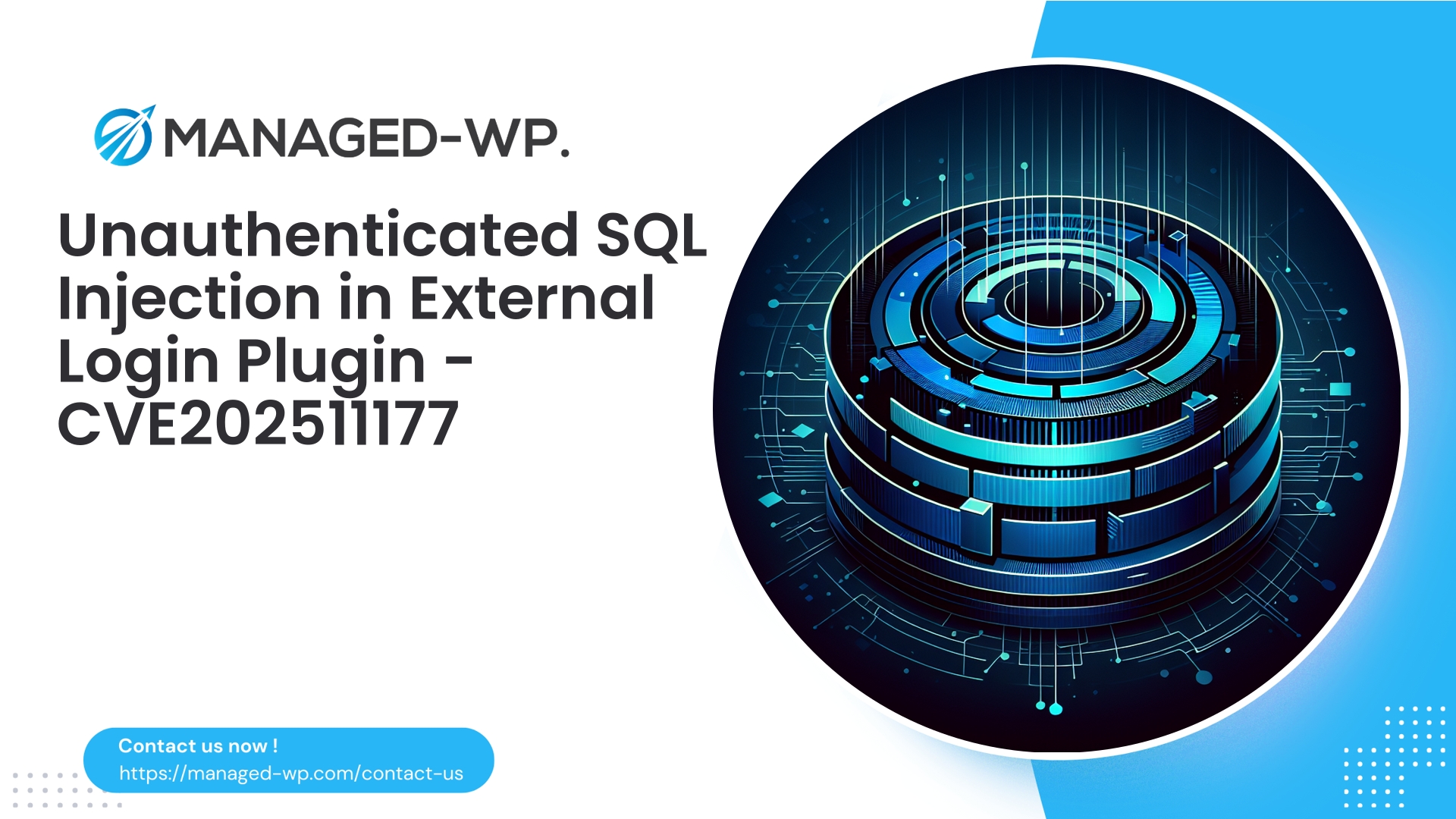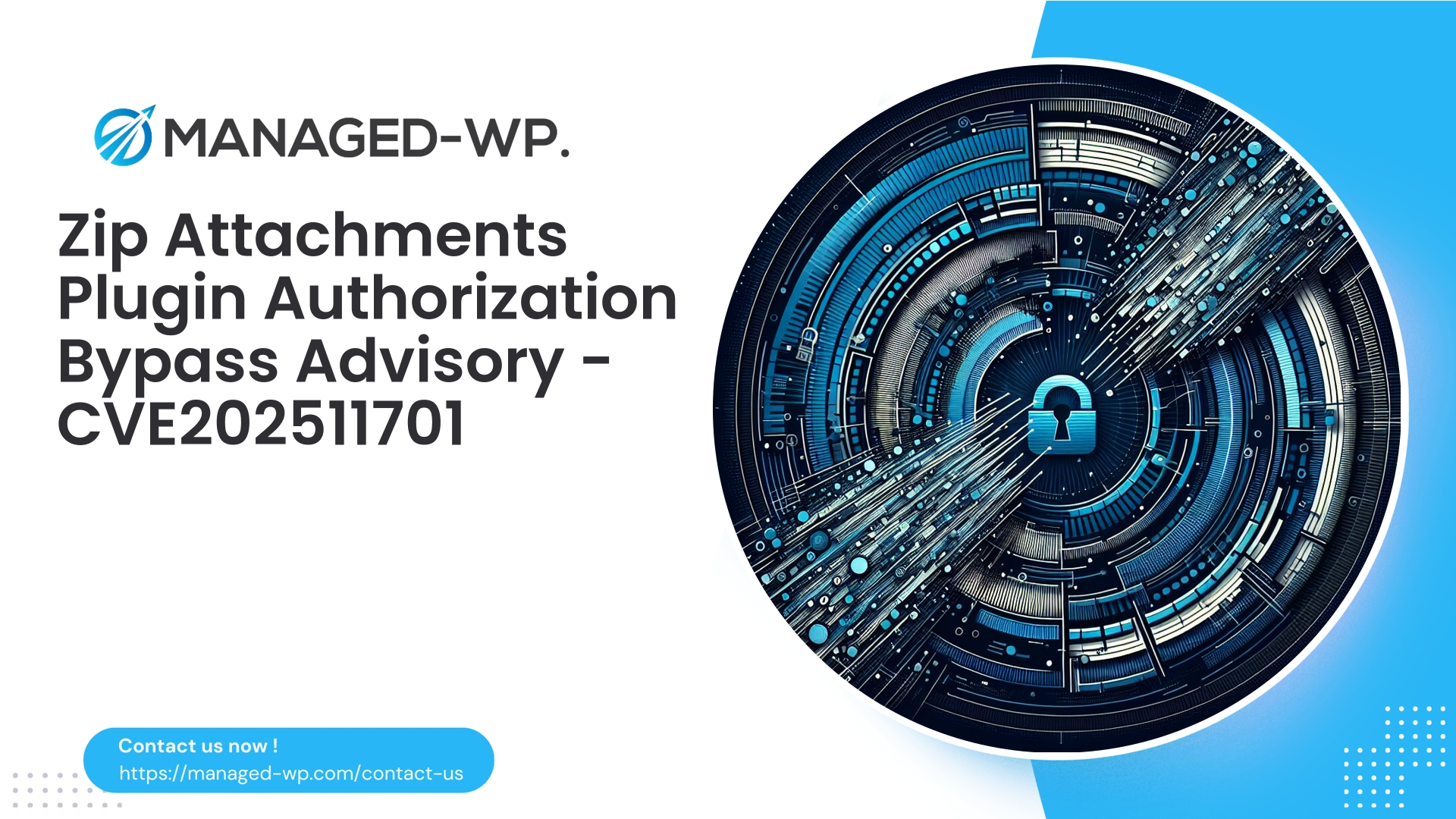| Plugin Name | External Login |
|---|---|
| Type of Vulnerability | Unauthenticated SQL Injection |
| CVE Number | CVE-2025-11177 |
| Urgency | High |
| CVE Publish Date | 2025-10-15 |
| Source URL | CVE-2025-11177 |
External Login (<= 1.11.2) — Unauthenticated SQL Injection (CVE-2025-11177): Immediate Action Required for WordPress Site Owners
Author: Managed-WP Security Team
Date: 2025-10-15
Executive Summary
On October 15, 2025, a critical unauthenticated SQL injection vulnerability, tracked as CVE-2025-11177, was publicly disclosed impacting the External Login WordPress plugin (versions 1.11.2 and earlier). This flaw permits unauthenticated attackers to inject malicious SQL payloads via the plugin’s logging features, which can lead to database compromise, data disclosure, and complete site takeover. The vulnerability carries a high severity rating (CVSS 9.3) and requires no credentials to exploit.
As experienced cybersecurity professionals at Managed-WP, we have compiled this detailed advisory to equip WordPress site owners, administrators, and developers with clear, practical guidance. This includes risk analysis, detection tips, immediate mitigation strategies, and long-term security measures you must apply to protect your environments effectively.
Our analysis comes from real-world security operations protecting live WordPress sites through active vulnerability disclosure periods. This is not a purely academic discussion — it’s a call to action.
Quick Facts
- Vulnerability: Unauthenticated SQL Injection via plugin logging endpoint
- Plugin Affected: External Login (WordPress plugin)
- Vulnerable Versions: ≤ 1.11.2
- CVE Identifier: CVE-2025-11177
- Risk Level: High (CVSS 9.3)
- Authentication Required: None (Unauthenticated)
- Public Disclosure Date: 2025-10-15
- Official Patch Availability: Not yet released (as of disclosure)
- Recommended Immediate Action: Disable or isolate the plugin immediately
Why This Vulnerability Demands Urgent Attention
SQL injection remains one of the most severe security risks in web applications, enabling attackers to manipulate and extract backend database information. WordPress site data—ranging from user credentials to sensitive configuration options—is stored in its database. Unauthenticated access to SQL injection means attackers require no login, accelerating the window for mass exploitation and damage.
This vulnerability stems from unsafe logging practices in the External Login plugin, where externally supplied inputs are incorporated directly into SQL queries without proper sanitization or parameterization. This lapse enables injection of harmful SQL statements, with consequences including data theft, modification of critical data, or even system takeover.
Technical Overview (Non-Exploitative)
- The plugin exposes an API endpoint accepting input destined for a logging database table or WordPress options row.
- Input is concatenated into SQL statements directly, lacking proper parameterization or escaping.
- No authentication or validation gates protect this endpoint; any remote attacker can submit crafted payloads.
- Attackers can execute arbitrary SQL commands under the WordPress database user’s privileges.
Out of caution and responsible disclosure ethics, we do not publish exploit proofs here, focusing instead on prevention and remediation.
Potential Exploitation Scenarios
- Exfiltrating sensitive data: hashed passwords, emails, API keys, and plugin configurations.
- Modifying site data: creating unauthorized admin accounts or injecting backdoor URLs via options.
- Damaging site integrity: dropping or corrupting essential database tables.
- Gaining remote code execution through chained vulnerabilities in themes or plugins.
- Escalating privileges to the server level if database credentials are shared.
Automated scanners will almost certainly target this vulnerability rapidly given public disclosure. Monitor your logs closely.
Indicators of Compromise — What To Watch For
Check for the following signs if your WordPress installation uses External Login ≤ 1.11.2:
- Unusual or slow SQL queries
- Spike in queries containing SQL keywords (SELECT, UNION, INTO OUTFILE, –, /*) in logging fields.
- Abnormally slow or malformed database queries (review slow query logs).
- Anomalous plugin log entries
- Log entries with embedded SQL syntax or obfuscated payloads.
- Long single-column strings resembling attack vectors.
- Unexpected admin user creation
- Query recent registered users:
SELECT ID, user_login, user_email, user_registered FROM wp_users ORDER BY user_registered DESC LIMIT 10; - Identify accounts created outside normal periods.
- Query recent registered users:
- Suspicious changes to wp_options
- Look for edits made to critical settings such as siteurl, home, active_plugins.
- Spot suspicious autoloaded entries containing external URLs or encoded strings.
- Unexpected file modifications
- New or altered PHP files in uploads, mu-plugins, or themes/plugins directories.
- Malicious webserver requests
- Requests to plugin endpoints with odd GET/POST data containing SQL tokens or encoded characters.
- Outbound network activity
- Unusual HTTP/S calls to unknown domains indicating data exfiltration attempts.
Discovering any of these may indicate compromise. Immediate incident response is warranted.
Immediate Mitigation Steps — Prioritized Actions
- Place your site into maintenance or restricted access mode
- Limit traffic using hosting controls, firewall rules, or a WAF during assessment.
- Deactivate or remove the External Login plugin
- Disabling the plugin is the fastest, most effective mitigation.
- If admin dashboard access is limited, rename the plugin folder via SFTP/SSH:
wp-content/plugins/external-login → external-login.disabled
- Block plugin-related endpoints via server rules
- Use .htaccess or server configuration to deny access to plugin log paths.
- Example for Apache:
# Block access to vulnerable plugin file <Files "external-login-handler.php"> Require all denied </Files> - Customize filename as necessary; prioritize full plugin deactivation over relying on obscurity.
- Deploy WAF rules to intercept dangerous payloads
- Block SQL keywords or comment sequences in requests targeting the plugin endpoints.
- A modern WAF greatly reduces risk from automated attacks and repeated probes.
- Rotate database credentials if compromise is suspected
- Change passwords in wp-config.php and database credentials only after thorough forensic analysis.
- Credential rotation is ineffective if attackers already possess file-level access.
- Audit and block suspicious IP addresses
- Use hosts.deny, firewall rules, or WAF blocklists to isolate malicious actors based on logs.
- Backup your site and database immediately
- Preserve the current state for forensic analysis and prepare fallback options.
Virtual Patching — The Role and Limits of a WAF
A Web Application Firewall (WAF) can provide protective buffering by filtering malicious payloads before they reach WordPress. However, the protection isn’t absolute.
Capabilities of a WAF:
- Intercept and block common SQLi payloads targeting known vulnerable endpoints.
- Throttle or geo-block suspicious traffic to slow automated attacks.
- Flag and log intrusion attempts, aiding incident detection.
Limitations of WAF protection:
- Sophisticated, obfuscated SQLi attacks may bypass generic filters.
- WAFs cannot restore altered database content or remove backdoors.
- Logging-based SQLi poses filtering challenges due to varying benign input patterns.
Note: Industry disclosures indicate this vulnerability’s complexity limits straightforward virtual patching. Despite this, a layered approach combining WAF rules, endpoint blocking, and plugin deactivation is the best interim defense.
Recommended Example WAF Rules (Sanitized Patterns)
Below are templates to tailor in your WAF management console or firewall setup, designed to minimize false positives while targeting likely attack vectors. Test these rules in detection mode first.
Example 1: Block SQL keywords combined with comment markers:
SecRule REQUEST_URI|ARGS|REQUEST_HEADERS "@rx (?i)(\b(select|union|insert|update|delete|drop|concat|into)\b).*(--|/\*|\#|;)"
"id:1002001,phase:1,deny,log,msg:'Block probable SQLi payload',severity:2"
Example 2: Block SQL comment tokens in parameters:
SecRule ARGS_NAMES|ARGS "@rx (?i)(\-\-|/\*|\#)"
"id:1002002,phase:2,deny,log,msg:'Block SQL comment markers in parameters',severity:2"
Example 3: Limit request parameter sizes:
SecRule ARGS "@validateByteRange 0-4096" "id:1002003,phase:2,pass,log,msg:'Large parameter blocked'"
Example 4: Restrict access to plugin API endpoints (IP whitelist):
# If the plugin endpoint is /wp-json/external-login/log: SecRule REQUEST_URI "@contains /wp-json/external-login/" "phase:1,pass,ctl:ruleEngine=DetectionOnly" SecRule REMOTE_ADDR "!@ipMatch 192.0.2.0/24 203.0.113.0/24" "phase:1,deny,msg:'Block external access to external-login API'"
Important: Avoid broad SQL-related blocking across your entire site to prevent breaking legitimate functionality. Always test rules in a controlled environment.
Temporary Code-Level Mitigation via MU-Plugin
If immediate plugin removal is impractical—such as for large multisite environments dependent on External Login—you can deploy a “must-use” plugin to disable the vulnerable logging handler or filter input before database interaction. MU-plugins load early and bypass normal admin deactivation.
Example mu-plugin (adjust hook and method names according to your plugin’s code):
File path: wp-content/mu-plugins/disable-external-login-logging.php
<?php
/**
* Emergency mitigation: disable External Login logging handlers
* Place this file in wp-content/mu-plugins/
*/
add_action( 'plugins_loaded', function() {
// Remove specific logging action if it exists
if ( has_action( 'external_login_log_event' ) ) {
remove_action( 'external_login_log_event', 'external_login_handle_log', 10 );
}
// Disable logging method if plugin uses a class instance
if ( class_exists( 'External_Login_Main' ) ) {
global $external_login;
if ( isset( $external_login ) && is_object( $external_login ) ) {
if ( method_exists( $external_login, 'write_log' ) ) {
$external_login->write_log = function() { return true; };
}
}
}
}, 1 );
Notes:
- This example must be customized to match the plugin’s actual hooks and class methods.
- Test thoroughly in a staging environment prior to deployment.
- Where possible, full plugin deactivation is preferable.
Guidance for Hosting Providers and Managed Service Operators
- Implement network-wide WAF rules to block requests targeting known vulnerable plugin endpoints.
- Globally deny payloads containing SQL injection patterns and comment sequences aimed at logging routes.
- Notify affected customers promptly with clear instructions to mitigate or remove the vulnerable plugin.
Recovery & Remediation — Step-by-Step Checklist
- Isolate affected sites by restricting incoming connections and disabling services if needed.
- Preserve forensic artifacts: server images, database exports, and logs stored securely offline.
- Restore from known-good backups predating the compromise, verifying no injected code remains.
- Rotate all access credentials: database, FTP/SFTP, hosting panel, API keys, and secrets.
- Reinstall WordPress core, themes, and plugins from official sources; avoid compromised backups.
- Conduct thorough malware scans and inspect for web shells or unauthorized PHP files.
- Review the database for suspicious wp_options or user accounts.
- Notify stakeholders and users according to applicable data breach regulations.
- Perform root-cause analysis to prevent recurrence and improve incident response.
Long-Term Security Hardening Recommendations
- Enforce Principle of Least Privilege: Limit database user permissions configured in wp-config.php to only necessary capabilities, avoiding FILE privilege unless absolutely required.
- Keep All Components Updated: Promptly apply updates to plugins, themes, and core WordPress installations. Subscribe to reputable security advisories.
- Leverage Managed Web Application Firewalls: Use behavioral and signature-based rules to defend against emerging threats and zero-day exploits.
- Audit Plugins Before Installation: Prefer plugins with active maintainers and transparent security practices.
- Implement File Integrity Monitoring: Detect unauthorized changes to key WordPress files.
- Adopt Secure Coding Practices: Ensure all custom development properly sanitizes and parameterizes user input before database interaction.
Testing Safely for Targeting
- Do not run any exploit code against production systems.
- Use read-only copies of your site database and files within isolated, controlled environments to investigate.
- Avoid public posting of exploit code to minimize exposure.
Frequently Asked Questions (FAQ)
Q: Is an official plugin patch available?
A: At the time of disclosure, no official patch has been released. Monitor the plugin’s page on WordPress.org and official channels for updates. Apply patches immediately upon availability.
Q: Can I rely solely on virtual patching?
A: Virtual patching reduces risk but is not foolproof for logging-based SQL injection. Fully disabling the vulnerable plugin remains the safest course.
Q: Is WAF protection sufficient?
A: A quality WAF significantly reduces risk, but should be combined with plugin deactivation, monitoring, and credential rotations for best outcomes.
Q: Should I rotate my database credentials now?
A: Rotate credentials if there is any suspicion or evidence of compromise, but only after capturing forensic snapshots and performing cleanup.
Example Forensic SQL Queries
Run these on a read-only copy or backup database to detect suspicious activity:
- Recent user registrations:
SELECT ID, user_login, user_email, user_registered FROM wp_users ORDER BY user_registered DESC LIMIT 20;
- Recent large options (to detect suspicious autoloaded data):
SELECT option_name, option_value, autoload FROM wp_options WHERE autoload = 'yes' ORDER BY LENGTH(option_value) DESC LIMIT 50;
- Search plugin log tables for SQL keywords:
SELECT * FROM wp_external_login_log WHERE message REGEXP '(SELECT|UNION|INSERT|UPDATE|DELETE|DROP|INTO|--|/\\*)' LIMIT 200;
Note: Adjust
wp_external_login_logto your plugin’s actual log table name.
Communications Guidance
- Be transparent with internal teams about the high-severity SQL injection risk and immediate mitigation efforts.
- If user data may have been exposed, comply with applicable breach notification regulations and consult legal advisors.
- Keep customers informed about remediation progress and encourage password resets where data exposure is confirmed.
Managed-WP Recommendations — What To Do Right Now
- Immediately disable the External Login plugin on affected WordPress instances.
- If disabling is not feasible, implement strict WAF and server rules to block plugin logging endpoints.
- Create backups and collect logs for forensic investigation.
- Monitor your environment closely for signs of compromise and engage your host or security team as needed.
- Once an official patch is available, apply it promptly and verify site integrity post-update.
Post-Compromise Recovery Overview
- Rapidly isolate affected sites to prevent further damage.
- Engage professional incident response if exposure or damage is extensive.
- Rebuild sites from verified clean backups; avoid backups with injected code.
- Enhance defenses including WAF deployment and file integrity monitoring.
- Conduct a thorough root cause analysis and update your security stance accordingly.
Final Security Advisory
Security can often be overlooked until a crisis hits. Vulnerabilities such as CVE-2025-11177 underscore the critical need for defense-in-depth strategies: robust firewalling, prompt patch application, thorough monitoring, and well-documented incident response plans. Operators of multiple WordPress sites or managed hosting providers should prioritize these recommendations to safeguard their entire portfolio.
Protect Your WordPress Site Now with Managed-WP Security Solutions
To immediately strengthen your site’s defenses during this active threat, Managed-WP offers comprehensive managed security services, including a basic no-cost plan that provides essential protections such as a managed firewall, advanced WAF capabilities designed for WordPress, malware scanning, and mitigation against top OWASP risks.
Get started with Managed-WP Free Plan: https://my.wp-firewall.com/buy/wp-firewall-free-plan/
Why choose Managed-WP Basic (Free)?
- Rapid deployment to shield your site in minutes.
- Managed WAF fine-tuned specifically for WordPress security threats.
- Continuous malware scanning and attack detection.
- No bandwidth limits, scalable security for growing sites.
For enhanced remediation assistance, including automatic malware removal and advanced rule customization, consider our Standard or Pro plans. During active vulnerability exposure, the free Basic tier offers an excellent baseline defense.
Immediate Next Steps — Copy-and-Paste Action List
- Create a full backup of your site and database immediately (store copies offline)
- Deactivate the External Login plugin on all sites running affected versions (≤ 1.11.2)
- If unable to deactivate, apply server-level blocking rules and enable WAF protections
- Scan system logs, users, option tables, and files for signs of compromise
- Rotate credentials (database, SFTP, control panel) if compromise is suspected
- Stay updated on official patches and apply promptly once available
- Consider enabling Managed-WP Basic (Free) protection: https://my.wp-firewall.com/buy/wp-firewall-free-plan/
If additional support is needed, Managed-WP can provide:
- Custom runbooks tailored to your environment, including exact plugin paths and WAF rule configurations.
- Phased WAF rule sets for gradual deployment from detection-only to enforcing mode.
- Customized mu-plugins designed to safely disable vulnerable logging functions (requires analysis of plugin internals).
Contact our security operations team through your Managed-WP dashboard to prioritize assistance.



















